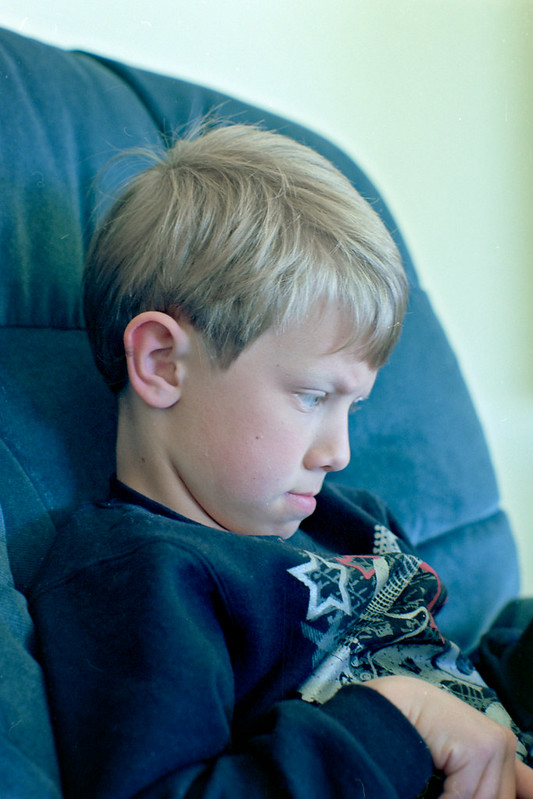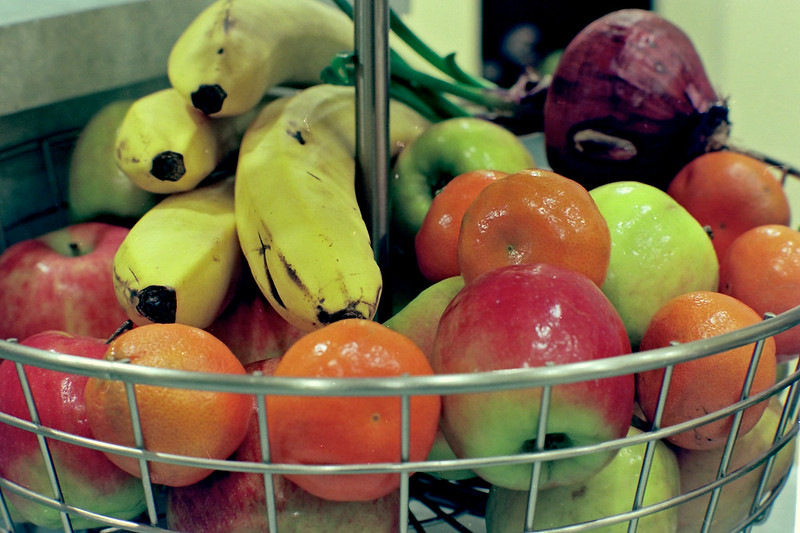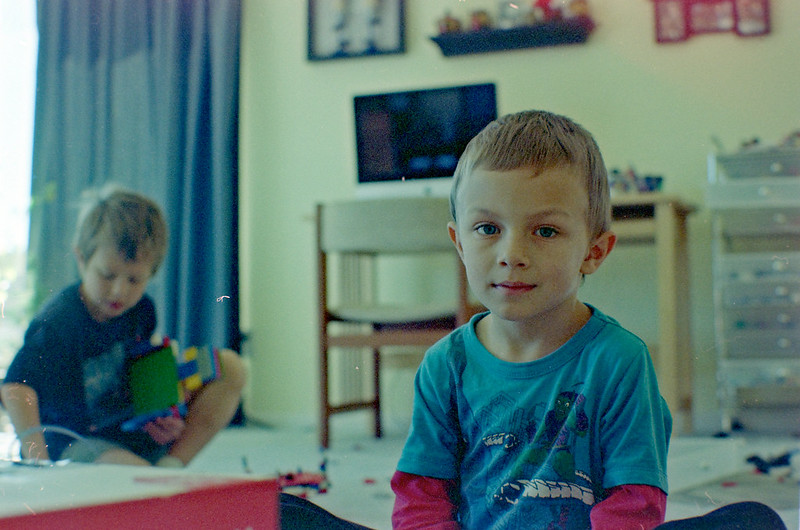I spent nearly all day today DSLR scanning some negatives and I wanted to share my experience here.
Let me begin with the bottom line : it works but it takes work.
So how does it work? It takes some serious Google searching across many forum sites to see how people configured their cameras. Nearly everyone uses 35mm or 50mm lens with an extension behind it to connect to the camera body and spacers in the front that connect to a slide/film duplicator. I used my A series 50mm f/1.4 lens with ~30mm of extension behind it. My tubes are just cheap knock-offs from China purchased off of eBay for ~$10. They are sectioned so I can add or remove sections within the assembly to make the system longer or shorter. The fit and finish is rough and my lens ends up mounting almost upside down. That's not a big deal as long as everything is functional. I have a series of step up/down rings and spacers after my lens which connect to an Accura slide/film duplicator. This duplicator seemed like a nice kit because it is expandable and collapsable. I thought I could use this feature to set a rough focus and fine tune the focus with the lens' focus ring. The problem with this feature on the Accura is that the sliding film holder may or may not end up sitting parallel to the image sensor way in the back inside the camera. I decided to collapse the holder and make up for it by adding another ring before it as a spacer. Doing this seemed to make the image more parallel. My Accura kit came complete with instructions and a couple of rings. These kit rings are important because the threads on the Accura are not the standard 49mm, 52mm, 55mm, etc filter threads we are used to today. They are part of a system called Series which has its roots in the early days of photography.
Here is a picture I took of my setup when I was at work earlier last week.

There is a large silver spacer that wombat2go made for me. It's basically a M42 gender-bender. I was going to use my M42 bellows here but it turned out that it could not collapse enough to achieve focus. That's OK because now I feel future-proofed if Pentax ever releases a FF.

Then I'll use my bellows.
Here's a link to one of the best examples and explanations of a DSLR scanning configuration.
The Boy With Illuminated Measles: Digitising old negatives - Part 1 - kit
An Accura duplicator was used in that example.
Illuminating the negative was easy. Most people use a flash to illuminate the negatives but I used daylight. I mounted the camera on a tripod and pointed the camera out the window on a bright day. Some people say gray cloudy days work better than clear bright sunny days. The weather was partly cloudy today and I had bouts of both kinds of illumination. It didn't seem to make much of a difference in my case.
Focusing is very easy through both the OVF and LCD. Set your lens aperture wide open and your DoF is very, very thin. You will see when the negative comes into focus.
I set my ISO to 100 and tried sampling the negative at f/5.6, f/8, f/11, f/16, and f/22. Through this trial and error I found that f/16 delivered the sharpest images. Now I know that diffraction begins to set in but I'm not sure if the same rules and guidelines from non-extension use apply here. It seems that extensions stress the optical performance of a lens. Maybe the aberrations and defects which were too small to notice before are stretched and expanded like a marshmallow in a microwave. Does stopping down the aperture to f/16 help the lens bend and refract the light back down to something we would call sharp?
I also found the 2-second timer and the Composition Adjustment function in my K-30 very handy. Although camera shake shouldn't be an issue here, using the 2-second timer allowed me to let go of the camera so there was no chance I could bump it or do something strange to knock the negative out. I used the Composition Adjustment to rotate the sensor and align it with the negative.
I didn't worry about setting the white balance because I was shooting in RAW which allows me to change it willy-nilly. All of my RAW images are process in Apple Aperture. In another thread I posted a link to a tutorial on how to process negatives using Aperture. Here is the link again:
my infinite wisdom: Inverting DSLR-Scanned Negatives in Aperture
I followed this process with two exceptions. First, rather than manually set my white and black points in the "Curves 3" section I use the Auto feature. Second, I also do a lot of tweaking to the colors using the Curves vs. the Levels that this guy uses. I think Curves and Levels operate on the same parameters but Curves offers more flexibility in adjustment. Use what feels comfortable. I ended up using both.
I started off DSLR scanning a negative from a 1994 mountain biking trip I took with my father to Colorado. He took a picture of me riding well ahead of him on fire trail. I don't know how well this will show on everyone's monitors but ...

IMGP2756 DSLR Colorado by
Never Off, on Flickr
Obviously, you can click on the image to see the full size file. The film was Kodak Gold 200 and I think he had a P&S of some sort. There are some issues with this image such as soft corners and strong contrast. The soft corners are on the source material and the contrast is a natural consequence of scanning film. This negative was made to be printed and photo paper has low contrast. To make up for it the film will have high contrast. So, shadows are black and highlights are blown out. I think this could be an example of film having a higher dynamic range than a digital image sensor. The image sensor could not accommodate the wide range of illuminations. If you zoom in you can see some film grain. Some of the finer details are washed out but I don't know if my K-30 could have done much better if it had traveled back in time to 1994 and taken this same photo. I was pleased and impressed with the quality of the image so I decided to move on to some recently developed Kodak Ektar 100.
This is where the fun begins! Ektar is a modern film that claims to have some of the finest grain on the market. I would be hard pressed to disagree. Here's an example.

IMGP2779 DSLR Reading by
Never Off, on Flickr
At worst it looks like high ISO noise but otherwise you can say that it adds a soft and romantic texture to what could have been a dull and sterile shot. Ektar is advertised to have extremely high contrast and that's another point I agree on. I had to tone down the intensity a lot in that shot. Here is a shot at full throttle.

IMGP2775 by
Never Off, on Flickr
The colors scream here! They are almost electric! I think this would be the same as a "Vivid" setting in a camera's JPG engine. If that wasn't enough to blind you then here's a floodlight of color.

IMGP2790 DSLR Fruit Bowl by
Never Off, on Flickr
For as garish as it looks, I have to confess that the fruit bowl really does look like that when I think about the lighting and the color scheme of my kitchen.
I have been showing the pretty side of DSLR scanning but now I want to show you the ugly side of it : expired film, runny emulsions, dust, and grain! Let's start with an example.

IMGP2801 DSLR Tad by
Never Off, on Flickr
This is Kodak Gold 200 film that was in a SF1n camera package I bought off of eBay. I have no idea how old the film is nor how the camera was stored. My guess is that the film is 10+ years old and there was no temperature controls. It got hot in the summer and cold in the winter. You can see my two kids making a mess on the floor with their Legos. You can also see muted colors throughout, blotchy grain everywhere, and color shifts in the upper right hand corner (the picture frame should be black - it's red). I'm sure there's a lot of digital tools out there that are beyond my skill and wallet which could clean up this image but it's not worth it. I'll go with the whole lomography movement and say that it looks "grungy" and "hip". It's still a romantic shot and I think there is an aspect of lomography I can appreciate but I would have been very disappointed if this would be the best DSLR scanning could ever be - lomography or not.
Here's another example with an emphasis on dust.

IMGP2794 DSLR Wonder Woman by
Never Off, on Flickr
From what I understand, stopping down a lens helps make the light more coherent so it strikes the image sensor in focus. This is a result of the increased DoF. Increasing the DoF is a three dimensional operation. It sharpens the image from left to right and front to back. The DoF was so deep that it brought all the dust inside the lens into focus on the image sensor! There was also some dust on the film too because it fell on my carpeted floor. No matter how many times I goosed it with my Giottio Rocket Blaster and dusted it my LensPen I simply could not get all the dust off. Now I have to confess that I cheated a bit in my previous images where I could. I used the touch-up feature in Aperture to get rid of most of the dust but it also wasn't nearly this bad. No way. This is very, very dusty!
And now I come to the end of my story telling. If you stayed with me through all of this then you deserve a gold star!

I spent a lot of time thinking about the best to go with digitizing my negatives and it seemed like there isn't a good low cost film scanner for 35mm film. Claimed resolutions fell short by as much as 50% and there are noise issues, focusing issues, etc. Using my K-30 gives me a bit over 5200 DPI resolution for the sensor which is almost overkill here, eliminates focusing issues (although it introduces dust issues), and gives me access to a sensor with low noise and a relatively wide dynamic range (but not wide enough for all of film's dynamic range). Plus there's the hassle of spending $200 on a scanner and finding a place for it. Not including the camera and lens, the DSLR scanning hardware cost me $50 tops and I probably could have done better than that. This solution may not be perfect but I think the compromises are worth the result considering the low cost. It's this low cost that makes the recently announce Pentax bellows seem overpriced to me. I spent $50 to get the IQ shown here. What would another $1150 get me? Would it be worth it? I'm not a professional or archivist. Would I spend a bit extra to get something a bit more elegant and have the ability to DSLR scan 120 film and have a Ricoh/Pentax name on it? Sure - just not $1150 more!!
I hope this (long) post and tutorial will help others looking into DSLR scanning.
Questions? Comments? Rumors? Fantasies?

Last edited by 6BQ5; 04-26-2014 at 06:23 PM.


 Similar Threads
Similar Threads 



 Then I'll use my bellows.
Then I'll use my bellows.










 Petapixel did a comparison between an Epson V700, a professional grade drum scanner, and a Canon 5D Mark II. I would assume the V700 in this test was tweaked and tuned to create the best image possible.
Petapixel did a comparison between an Epson V700, a professional grade drum scanner, and a Canon 5D Mark II. I would assume the V700 in this test was tweaked and tuned to create the best image possible.
 Full res ->
Full res -> 



 Post #1 by 6BQ5
Post #1 by 6BQ5








